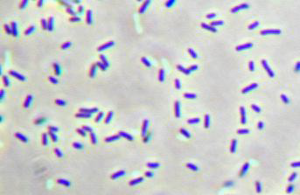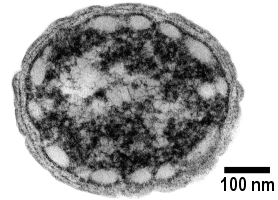Chlorobium tepidum
A Microbial Biorealm page on the genus Chlorobium tepidum
Classification
Higher order taxa
Domain: Bactera; Phylum: Chlorobi; Class: Chlorobia; Order: Chlorobiales; Family: Chlorobiaceae
Species
Genus: Chlorobaculum; Species: Chlorobium tepidum

Description and significance
Chlorobium tepidum is an anaerobic phototrophic bacterium that is also a thermophile. As a member of the Chlorobiaceae family, it is a model organism of green sulfur bacteria. The habitats of this bacterium include anoxic and sulfide-rich waters, mud, sediments, microbial mats, and even microbial consortia. The cells of this bacterium are gram-negative nonmotile rods of varying lengths that photooxidize reduced sulfur compounds. C. tepidum was isolated from certain acidic high sulfide New Zealand hot springs. Under photoautotrophic conditions, the growth rate of this bacterium is faster than any other anaerobic phototroph as generations are produced about every two hours. Consequently, it is an ideal candidate for studying photosynthesis and autotrophy in green bacteria.
Genome structure
The genome of C. tepidum has been completely sequenced. Its genome is one circular DNA molecule that consists of 2,154,946 basepairs. Through genome comparisons, it has been identified that many genes in C. tepidum are highly conserved among photosynthetic species, and though they have no clear function, they may play important roles in photosynthesis or photobiology.

Cell structure and metabolism
C. tepidum are gram-negative cells that harvest light through special photosynthetic systems known as chlorosomes. Chlorosomes contain highly aggregated light-harvesting centers, including bacteriochlorophyll c and carotenoids that are surrounded by a protein-stabilized galactolipid monolayer that lies at the inner surface of the cytoplasmic membrane. Two unusual features of this bacterium are its inability to produce oxygen and its low toleration of oxygen despite being a photosynthetic organism. In addition, C. tepidum has the ability to fix carbon dioxide using a reverse tricarboxylic acid cycle using electrons from hydrogen or reduced sulfur.
Ecology
Due to their anaerobically photosynthetic nature, C. tepidum and other green sulfur bacteria have been suggested to be among the first photosynthetic organisms that arose during a time when there was a low amount of oxygen present on Earth. Consequently, C. tepidum can be found in anoxic and sulfide-rich waters, mud, sediments, and microbial mats. The optimum temperature for such bacterium to grow ranges from 47–48°C. C. tepidum can transform sulfur available in the environment around them into a form that can be absorbed by other living organisms.
Pathology
C. tepidum is not known as of today to cause diseases.
Application to Biotechnology
By using the sulfur available in their surroundings, C. tepidum play an important role of converting sulfur into a form that can be absorbed by other living organisms.
Current Research
Marine biologist Thomas Hanson was awarded a $849,460 over five years for his research on understanding how microorganisms are able to survive and compete in the environment. Instead of focusing on the negative aspects of bacteria, Hanson has chosen to study how microorganisms contribute to the maintenance of favorable conditions for life. Hanson has decided to identify and characterize the genes and proteins present in C. tepidum and how they contribute to the bacterium’s ability to transform sulfur compounds into usable forms for other organisms.
References
PennState: Research on Chlorobium tepidum in the Bryant laboratory
Edited by student of Rachel Larsen and Kit Pogliano
